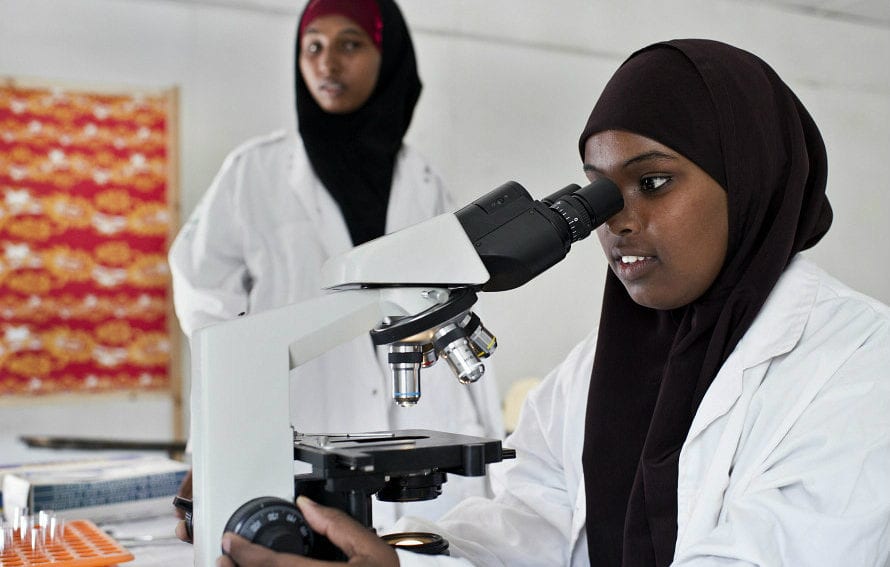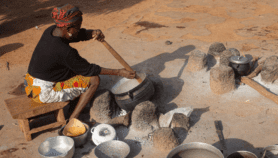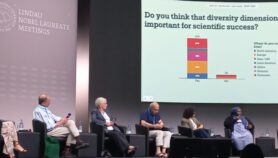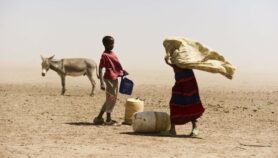By: Maina Waruru
Send to a friend
The details you provide on this page will not be used to send unsolicited email, and will not be sold to a 3rd party. See privacy policy.
[NAIROBI] For many years, Irene Wattanga has been one of only a handful of women working as a university mathematics lecturer in Kenya. She first worked as an assistant lecturer at the Jomo Kenyatta University of Agriculture and Technology (JKUAT) in Nairobi, before becoming a fully-fledged lecturer in the late 1990s.
But her desire to become a more accomplished master of mathematics — a subject widely shunned due to its perceived difficulty — kept growing. So she applied for a doctoral scholarship, an award that many crave but few achieve.
Wattanga's lucky break came in 2000, when the African Network of Scientific and Technological Institutions (ANSTI), an NGO that promotes the development of African science and technology through training and research, awarded her a three-year PhD scholarship to study at the University of Botswana, Gabarone.
Long road to success
Established by UNESCO in 1980 with funding from the UN Development Programme and the German government, ANSTI has spent the past 30 years providing postgraduate scholarships, short-term training, visiting fellowships and grants to African scholars to help build their capacity in science, technology, engineering and mathematics (STEM).
The network was conceived in response to the outcomes of the Conference of African Ministers of Science and Technology, held in Dakar, Senegal, in 1974. At that meeting, the African ministers urged UNESCO to help African universities and research organisations engaged in training and research in science and technology to link-up. The aim was to enable those institutions to pool their human and material resources and contribute more effectively to the application of science and technology to development in Africa.
“This project targets young women and those in mid-level careers aged below 40 years to help them complete their PhD studies.”
Peggy Oti-Boateng, UNESCO
According to ANSTI's coordinator, Peggy Oti-Boateng at UNESCO’s Nairobi office, its initial aims were to develop a “critical mass of scientists and engineers” by establishing centres of excellence within the ANSTI network’s member universities, promoting research and collaboration on research projects, and producing textbooks and publications.
“ANSTI regularly commissions member institutions to publish policy briefs, discussion papers and books on emerging issues in science and engineering,” Oti-Boateng says. There are more than 100 such policy briefs and text books, as well as electronic curriculums in science and engineering, and the African Journal of Science and Technology.
Oti-Boateng explains that “since 2005, ANSTI has hosted a biennial Conference of Vice-Chancellors, Provosts and Deans of Science, Engineering and Technology (COVIDSET) to provide a platform for university leaders, policymakers, development partners, international scientific and engineering networks and the private sector to exchange ideas, examine challenges and opportunities, explore solutions and forge ahead to ensure the relevance of these fields in our new and changing world”.
One of its key outputs is the qualitative and quantitative analyses of science and engineering university training in Africa. In 2005, based on such analysis, the Dutch government provided a grant of US$1.3 million to enhance the capacities in training and research for African universities. Other development partners such as the African Development Bank continue to fund the ANSTI publication of the African Journal of Science and Technology on the recommendation of COVIDSET 2011.
The fifth conference took place in 2013, alongside a meeting for Africa’s education, science and technology ministers — an indication that governments appreciate ANSTI’s role and continue to recognise the critical part that science plays in Africa’s economic transformation and in attaining its development goals, says Oti-Boateng.
Nurturing postgraduates
But it is the mobilisation of resources for postgraduate grants such as Wattanga’s that has created the most impact.
Since its inception, ANSTI has awarded more than 300 master’s and PhD scholarships to students across Africa. They are part of the critical mass of Africa’s scientists and engineers. They work on teaching the application of science and engineering across various fields of academia and industry both in the private and public sectors. Among them, there are vice-chancellors of prestigious African universities and directors of research institutions, ministers of education, science and energy, and policymakers.
Competition for scholarships has been stiff, with stringent selection criteria. In 2013, for example, there were 150 applications — with ten of them from women — for just eight places.
The small number of women applicants reflects the fact that there are not that many women in STEM, but, according to Oti-Boateng, more women are now being encouraged to further their science careers after their first degree. They are being given priority in awarding of scholarships, and a percentage of available places are reserved exclusively for them.
A lack of funds is still “a huge challenge, as demonstrated by the high number of applicants and the few we are able to take”, Oti-Boateng says.
The grants programme’s main funders are UNESCO and the German Academic Exchange Service (DAAD), with the Carnegie Corporation of New York and the government of the Netherlands also making substantial contributions over the past five years.
And, more recently, African governments and regional bodies have also been showing interest. With what Oti-Boateng describes as an increased realisation among African governments that science and technology are critical to attaining development goals, ANSTI is now working more closely with the African Union, the African Development Bank, and the UN's Economic Commission for Africa.
Private-sector bodies are also getting on board, with a special spotlight on women. In 2011, the European beauty product corporation L’Oréal joined ANSTI’s list of partners, launching the L’Oréal Fellowship for Women Scientists in Sub-Saharan Africa. Since 2011, in partnership with UNESCO, the L’Oréal fellowship has supported 35 PhD scholarships for women, with grants of US$20,000 committed to each student.
“This project targets young women and those in mid-level careers aged below 40 years to help them complete their PhD studies,” says Oti-Boateng. And the scholarships have proved popular: 500 women applied in 2013 alone.
Hurdles to progress
Besides the struggle to find funding, ANSTI has found that some countries have been slow to engage with the programme, with the result that these countries have fewer engineers and scientists than others, Oti-Boateng says.
ANSTI is now trying to encourage more universities from these countries to become members. Other challenges include the low numbers of journals produced by African universities, the lack of adequate, relevant and updated textbooks, and the scarcity of science and engineering faculties.
Inadequate pay for university teachers, a failure to align training with industry needs and the fact that many science graduates seek careers in more lucrative fields such as banking are also major hurdles to the growth of science in Africa. In response to these challenges, ANSTI has been encouraging universities to improve working conditions to retain teachers and has been encouraging undergraduates to pursue careers in science, a difficult task since sectors such as banking also prefer analytically minded people like science graduates.
Shining examples
The ANSTI network encompasses close to 200 faculties and institutions in 35 countries. Wattanga is a shining example of ANSTI’s ability to help scholars — and women — attain their academic ambitions. She is now an associate dean at the engineering faculty of Kenya’s Multimedia University and says her doctorate enabled her to improve her research skills and use modern scientific methods to mentor young scientists.
Having succeeded in a subject “considered a male preserve”, she says that her teaching mathematics is an inspiration to her students both female and male. And she has ideas for how ANSTI can continue to empower its students.
“I wish to see ANSTI plan more workshops to enable its alumni to meet and encourage and mentor prospective beneficiaries; see a proper alumni association formed; and for joint community projects to be initiated,” she says. “This way, the benefits of ANSTI will be felt more widely.”
This article is part of a series Africa’s Minds: Build a Better Future produced by SciDev.Net in association with UNESCO, with funding support from the Islamic Development Bank.














